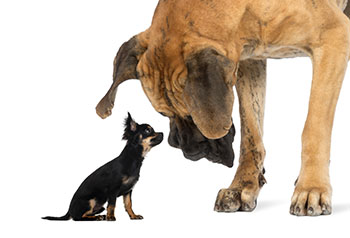
A Large Vaccine Problem For Small Dogs
 If you look at cats, they’re pretty much all the same size. It’s the same with other species like ferrets and horses.
If you look at cats, they’re pretty much all the same size. It’s the same with other species like ferrets and horses.
But no other species has such a vast variation in size and weight like the domestic dog does.
This creates a unique vaccination challenge, the consequences of which are starting to surface.
One Size Does Not Fit All
Did you know that a 160 pound Mastiff and a 10 pound Chihuahua both get the same amount of vaccine? Unlike every other veterinary drug, 1 ml of vaccine is given to every dog, regardless of his size.
Why is this a problem?
There seem to be a few problems with this approach. Researchers (Moore, Guptill, Ward et al, “Adverse events diagnosed within three days of vaccine administration in dogs” ) looked at veterinary records gathered from Banfield veterinary clinics for two years to find any trends in reactions suffered three days after vaccination. What they found was that small breed dogs (especially if they were young or neutered), were at the greatest risk.
In fact, the risk increased as the body weight went down, just like a sliding scale. Overall, dogs weighing 11 pounds or less were four times more likely than dogs over 99 pounds to suffer an adverse event (and medium sized dogs also had an increased risk over larger dogs).
Why Are Small Dogs More At Risk?
The answer to that is simple. Vaccines contain only a small amount of antigen for safety reasons; you wouldn’t want your dog to get rabies from the vaccine! So vaccines contain either small amounts of inactivated antigen or, more recently, subunit antigen particles that look like a virus to the body but can’t really stimulate much of an immune response on their own.
So the vaccine needs to contain some pretty toxic ingredients called adjuvants (stuff like aluminum) that make the body respond to vaccines quicker, longer and more actively. These adjuvants create an inflammatory response that can range from a bump at the injection site to allergic reactions, anaphylaxis and even cardiac arrest. With time, they may even lead to chronic allergies, joint disease and cancer – but we’ll stick to adverse events that occur within 72 hours of vaccination, because most vaccine reactions that occur outside that timeframe (and many do!) aren’t considered vaccine related by most vets and aren’t reported.
So that’s why small dogs are more at risk of vaccine damage…they get the lion’s share of adjuvants (and other things like mercury, formaldehyde and foreign animal protein) in their 1ml of vaccine.
The (Not So) Good News
If you have a small dog, the good news is that antibody titers seem to increase as body weight decreases. That means that the little guys should show protection when you titer test them (and you do titer test instead of vaccinating, right?)
The downside is that while high antibodies mean the body has responded to a vaccine, they also mean that the dog is in a pretty inflamed state and can set the stage for auto-immune disorders like allergies, hypothyroidism, diabetes, joint disease and more.
What About The Large Dogs?
Don’t feel too good about this if you own a large breed dog. Because vaccines are tested on medium sized dogs, the large and giant breeds might not be getting enough! This could be why many large breed dogs are more susceptible to parvovirus, even when vaccinated.
What To Do?
If you choose to vaccinate your pet, it’s a very good idea to run a titer test two to three weeks after the vaccination. This is good for the big guys, because any amount of titer means he will be protected, likely for life, and won’t need another vaccine.
If you have a small guy, ask your vet to give a smaller dose of the vaccine. Again, thanks to titer tests, you can measure whether the dose was large enough to produce immunity in your dog. If it does, he won’t need another vaccine.
There are inexpensive, in-house titer tests available. If your vet doesn’t offer one, encourage him to do so. Alternately, pay to have the titer test sent to a lab. It’s worth the money to do so, if it means protecting your dog from unnecessary vaccination.
What About Rabies?
While vets may be able to give partial doses of the core vaccines, the law requires them to give a full dose of the rabies vaccine. This is bad news indeed for the little guys. If you live in an area where rabies is required, make sure you give the vaccine no more often than necessary. It’s also a good idea to have a homeopathic vet on hand to deal with any possible vaccine reactions or issues. You can find a great homeopathic vet at theavh.org.
Remember that adverse events are vastly under-reported and the incidence of vaccine related disease is much higher than you would think. If you are wondering why you need to vaccinate less, you can view a list of vaccine related health problems and how long vaccines really last here.













No comments:
Post a Comment